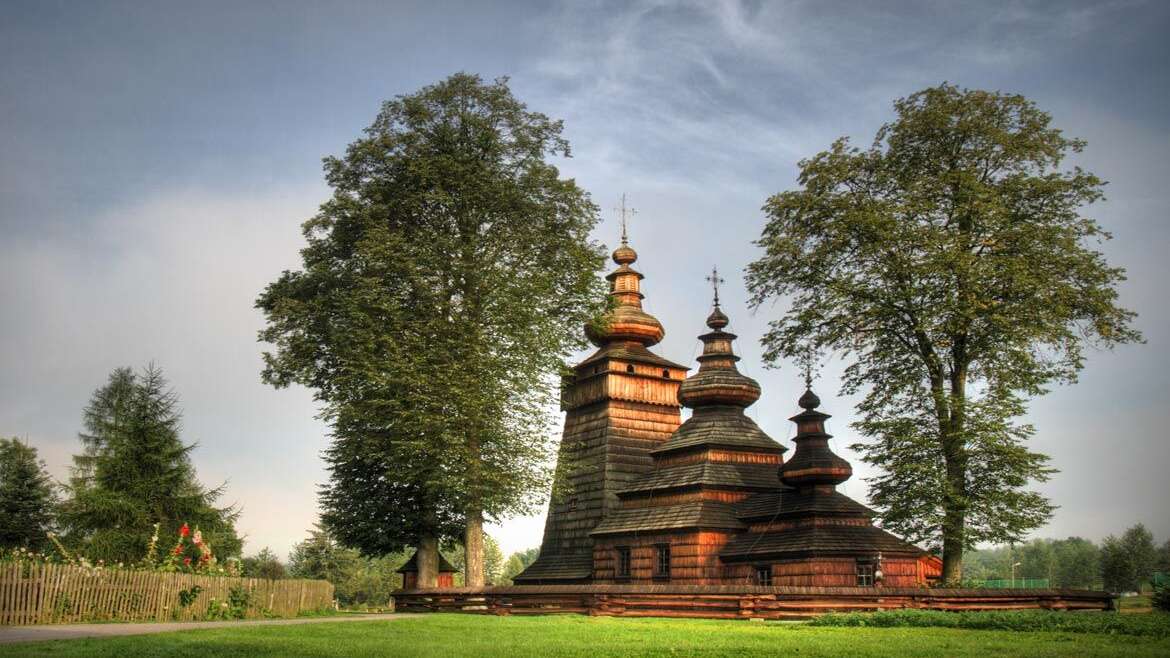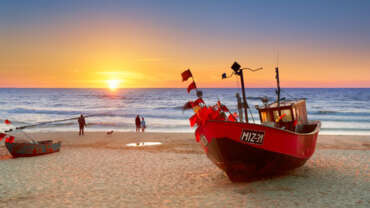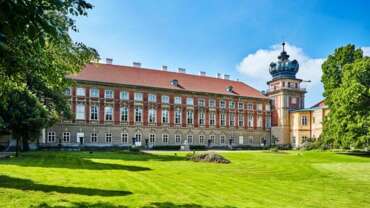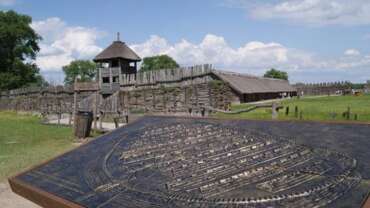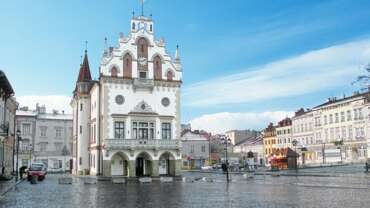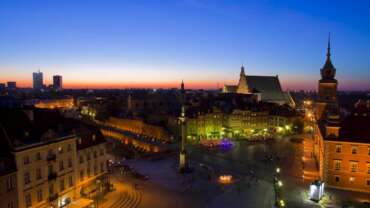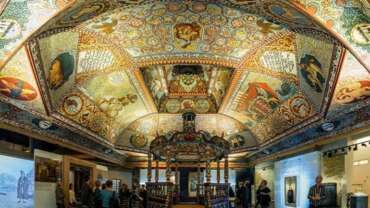Holy Places in Poland
Roman-Catholic sanctuaries are Poland’s landmarks. The majority of pilgrims f lock to the Pauline Monastery on Jasna Góra in Częstochowa. Here you will find the blessed icon of the Black Madonna, venerated both in Poland and abroad. The followers of other faiths have their sanctuaries in many places around the country: the Eastern Orthodox Church at Grabarka, the Protestants at Karpacz, Wisła and Cieszyn, and the Muslims at Bohoniki.
Catholics make pilgrimages to shrines, calvaries and to miraculous springs. Orthodox Christians take crosses to the holy Mount Grabarka and Jews are drawn to the tombs of their Tzaddiks in Lezajsk and Lelow. Just add to this the roadside crosses and chapels and we get the religious landscape of Poland.
The spiritual capital of Poland is Jasna Gora in Czestochowa with its miraculous painting of the Black Madonna which annually attracts millions of pilgrims. They travel on foot for several days and covering several hundred kilometres. They arrive at the Jasna Gora meadows by the 15th August, the day celebrating of the assumption of the Blessed Virgin Mary.
There are more than 200 various sanctuaries in Poland. Although mainly Marian, some are dedicated to Jesus Christ or other saints. Each has a miraculous painting like at Koden, Holy Lipka, Gietrzwald or Lezajsk, or a figurine as at Skepe, Bardo or Wawolnica. Some are also close to a spring which is said to have healing properties like the ones in Studzieniczna, Krasnobrod and Lesniow.
The oldest Polish sanctuary can be found in Gorka Klasztorna where, in 1079, our lady is said to have appeared before a shepherd. The most immense is the basilica in Lichen which can accommodate up to 30,000 people. The unique Holy Stairs are in the sanctuary in Sosnica and the smallest crowned statuette of the Virgin Mary stands in Gidle. It is only 9cm tall but is thought to be very powerful!
Poles enthusiastically participate in pilgrimages to calvaries, complexes of churches and chapels recreating the Way of the Cross in Jerusalem. The Mysteries of the Passion of Christ are held at all calvaries during Holy Week. The most famous one Kalwaria Zebrzydowska has been entered on the UNESCO World Heritage List. Other pilgrimage destinations include Kalwaria Paclawska, the St. Anna’s Mount or Wambierzyce.
Mount Grabarka is the most important place of worship for Orthodox Christians where crosses are erected on 19th July next to the church on the Holy Mount. An important holiday for the Polish descendants of the Tatars, that are followers of Islam, is Kurban Bajram, during which time cattle is sacrificed at the mosque in Bohoniki. Jews from all over the world are drawn to Lezajsk and Lelow to pray at the tombs of the Hasidic Tzaddiks, Elimelech and Dowid Biderman.
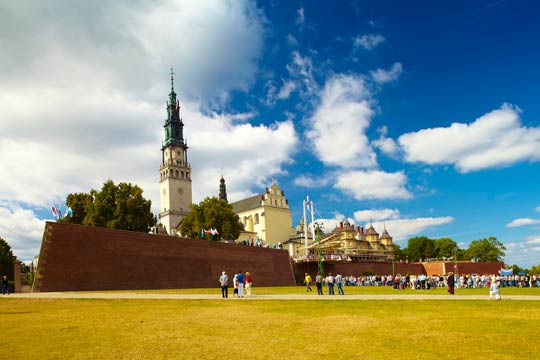
5 RELIGIOUS TREASURES OF POLAND
Jasna Gora
Located in the central region of southern Poland, Jasna Gora is the country’s national shrine. It is also a pilgrimage site of international importance, comparable to the holy sites of Jerusalem, Fatima, Rome, or Lourdes. Home to the nation’s religious relic, the Black Madonna displayed on a Baroque altar in the monastery chapel in Jasna Gora, the city attracts more than 4.5 million pilgrims a year from 80 countries.
Lichen
Home to the Sanctuary of Our Lady of Sorrows, Queen of Poland, Lichen Stary is currently known for the Basilica of Our Lady of Lichen, the largest church in Poland, and the miraculous painting of Virgin Mary, dating back to the times of Napoleon. It is visited by more than two million pilgrims every year. Apart from the Lichen Basilica, there is historic St. Dorothy’s Church, which housed the miraculous painting up to 2006.
Wadowice
Located some 30 miles southwest of Cracow, Wadowice is the hometown of John Paul II. “It is the place”, he once said, “where it all began.” Each year, hundreds of thousands of pilgrims and tourists come to Wadowice to see the modest apartment block where John Paul II lived as a boy, and to try the famous “kremowka”, Pope’s favourite cream-filled pastry.
Kalwaria Zebrzydowska
Founded in 1602, Kalwaria Zebrzydowska is the only Calvary in the world on the UNESCO list. It consists of the monastery and a number of Mannerist churches and chapels, housing the Holy Icon of the Mother of God of Kalwaria. Frequently visited by Pope John Paul II, the place attracts millions of tourists and pilgrims every year.
Niepokalanow
Established In 1927 by Maximilian Kolbe, Niepokalanow took its name from the Immaculate Heart of Mary Statue. Its founder, a Polish Franciscan Friar, who was sent to Auschwitz for hiding Jews during the Second World War, was canonized as a martyr as he had volunteered to die in place of a stranger in the camp. The philosophy of his life attracts nearly 700 thousand pilgrims every year, and so does the Panorama theatre, commemorating the 1000th Anniversary of Christianity in Poland. The theatre consists of 164 figures and highlights the most important events in the history of Poland and church.
LAGIEWNIKI SANCTUARY
In 2005 the Lagiewniki Sanctuary was even more popular than the famous French “La Salette” and every year it is visited by more than 2 million pilgrims. Both John Paul II and Benedict XVI have visited Lagiewniki during their pilgrimages to Poland.
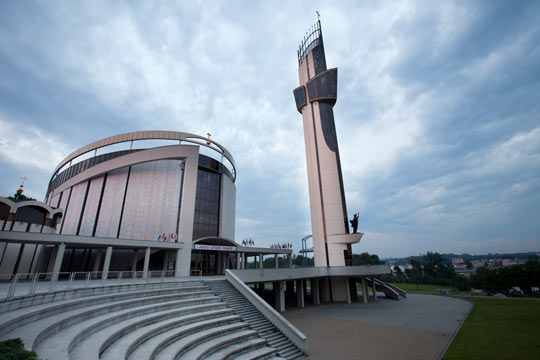
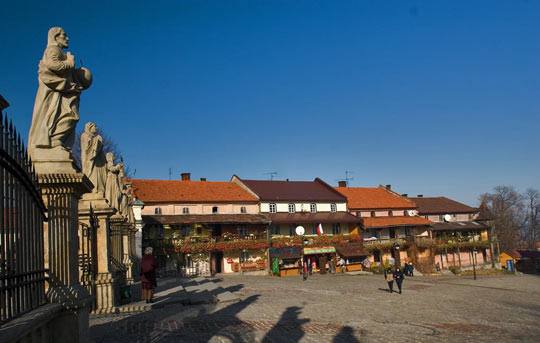
JERUSALEM SERVED AS EXAMPLE
The whole complex of chapels was built over the surrounding hills in the picturesque landscape of the Beskid Makowski. They all form the Kalwaria Zebrzydowska Religious and Landscape Park registered on UNESCO’s World Cultural Heritage List. The town owes its existence and subsequent fame to the Palatine of Kraków, Mikołaj Zebrzydowski, who in 1600 commissioned the church and monastery for the Bernardine Order as well as a complex of chapels similar to the Calvary in Jerusalem. He trusted the construction of the whole to the Flemish architect Paul Baudarth. The monastery with the Marian Sanctuary was erected in the late baroque style with some rococo decorations, adorned with cloisters and featuring mannerist wall paintings and precious canvases in its interiors.
With time more chapels were erected, eventually reaching 42 buildings, all set in the natural landscape and featuring the famous Calvary avenues. It takes about four hours to cover the whole trail of six kilometers. The Marian chapel in the shape of a heart, Pilate’s Praetorium, and Our Lady’s Tomb with its sarcophagus are the most spectacular edifices.
Every year thousands of pilgrims and tourists flock to Kalwaria Zebrzydowska. Famous church fairs combined with processions and the Passion plays attract throngs of people.
The little town of Kalwaria Zebrzydowska has other noteworthy historical monuments: the castle complex, old houses with church fair stands and hermitages.
It’s a convenient starting point for hikers who wish to enjoy interesting trails crisscrossing the Beskidy Mountain Range. Another place worth a visit from Kalwaria is Wadowice, birthplace of John Paul II who was often coming to the shrine as a pilgrim.
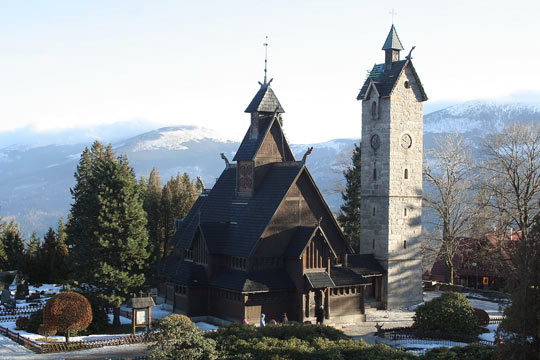
HISTORY OF WANG CHURCH
About a thousand similar wooden (stave) churches were built there then, yet till the present day only thirty one such churches survived in Norway, and this one in Karpacz Górny. Our Twin Parish in Hahnenklee, Germany, has also a wooden church built in 1908 according to the Norwegian designs. In the nineteenth century Wang Church proved too small and in need of costly renovation, and so a decision to sell it was made. The money was needed to pay back a loan taken for the construction of a new one.
Wang Church was built at the turn of 12th century in Vang which accounts for its present name. Vang was a settlement at Lake Vang in southern Norway.
About a thousand similar wooden (stave) churches were built there then, yet till the present day only thirty one such churches survived in Norway, and this one in Karpacz Górny. Our Twin Parish in Hahnenklee, Germany, has also a wooden church built in 1908 according to the Norwegian designs.
In the nineteenth century Wang Church proved too small and in need of costly renovation, and so a decision to sell it was made. The money was needed to pay back a loan taken for the construction of a new one.
Thanks to the efforts of a Dresden-based Norwegian painter, Professor John Christian Dahl, this great architectural experience of the Vikings was bought for the sum of 427 marks by the then king, Frederick William IV. A royal architect completed the working plan of the church building, and the edifice was taken to pieces so as to be shipped, in boxes, to Szczecin in 1841 and from there – to the Royal Museum in Berlin. The King, however, had abandoned the idea of having it reerected on the Peacock Island near Berlin and started seeking another site for the church to render its religious services.
Owing to the involvement of Countess Frederica von Reden of Bukowiec, in the spring of 1842 the church was moved to the Karkonosze Mountains so that it could be of use to the Lutherans living in Karpacz and its surroundings. The church therefore journeyed on barges along the river Odra to be later hauled by nine horse wagons.
The building site for the church was presented by Count Christian Leopold von Schaffgotsch of Cieplice. It is a slope of Czarna Góra (885 metres above sea level), midway between lower Karpacz and Mount Śnieżka.
To provide a few hundred square metres of a building plot necessary for the church, the rectory, the school and the cemetery the rocks were blown up and a six-metre-high retaining wall was constructed.
On August 2, 1842 King Frederick William IV himself laid a cornerstone for the church, and two years later on July 28, 1844 the solemn opening and the consecration of the church took place in the presence of the King, his Consort, Frederick- the Prince of Holland and other distinguished guests.
For the first time the bells were heard ringing from the bell tower of this church whose location is the highest among the Lower Silesian churches. The bells’ ringing made it known that from then onwards the church would provide the same service as it had in Norway.
Wang Church followed the best examples of the Scandinavian sacral architecture and is now a unique work of the old Nordic art. Built in the way the Viking longships were, that is without a single nail, it features wooden bolts and dovetails. The church was built from the Norwegian pine rich in resin which reveals unusual endurance.
The outer door frames, which you have just passed through, draw one’s attention to their half-columns decorated with a tangle of dragons and plants. On their capitals mounted are the stylized lions in their symbolic roles of the beasts which keep guard at the gates.
It is most incredible that in those days with such scarce tools available like the ones made from flint, horn or fishbone people were able to so masterly carve the beasts’ heads, their legs and furs. Quite unlike other ornaments these are facing outwards.
The age of the southern doorway on the right is revealed by the characteristic lunette which caps it and whose clover shape points to the twelfth century.
In the top corners of both doorways are the carved winged dragons right in the act of tearing apart the horizontally placed figure eight. Such an arrangement may symbolise the eternal and everlasting combat between good and evil.
Across from here, you can see the southern doorway which was carved by Eindridi in the first half of the twelfth century as the runic inscription, placed on the edge of the door frame reveals: “Eindridi carved me to the glory of St Olaf.”
The half-columns, which make decorative door frames, depict the Viking warriors’ faces, with their forked tongues sticking out. Such tongues represented the passing of knowledge and wisdom onto the following generations. The upper parts of the columns from the twelfth century, carved in the Byzantine style, are also true works of art. The carved figures of animals, plants and mascarons decorate these capitals.
The four columns placed in the middle of the main nave and the ones on its both sides may have been the masts of the Viking long boats. The remaining columns, which are in front of the altar and depict David’s victory over Goliath, and the Prophet Daniel in the lions’ pit were reconstructed by a remarkable sculptor – Jakub of Janowice. Sill another of his works is thecross made in 1844 from a single oak trunk and the figure of Christ, made from linden wood in 1846.
On both sides of the altar, made in 1980 by Ryszard Zając, standing are the two mounted candelabra. One shows a swan as a symbol of faithfulness, the other – a heart as a symbol of love. The candles in them are lit only during wedding ceremonies. Wang Church is well known as a church of successful marriages.
The font, the Lower Silesian baroque, made around 1740, comes from a dismantled church in Dziećmorowice, near Wałbrzych. The pulpit was made from the wood brought from Norway. The two boards hanging on the walls are used for displaying the numbers of hymns sung during services, and they date back to the year 1904. The church is surrounded with the cloisters which protect it against cold. In the days of old, people used to leave their weapons and fishing nets there. In medieval times they would do penance in there. The sunlight brightens the church interior through 174 little crown-glass windows. On leaving the church we can see some highly characteristic roof ornaments. The roof tops are decorated with pinnacles, i.e., the projections in the shape of gaping dragon mouths which resemble the ornaments characteristic of the Vikings’ longships. Thus the Karkonosze Wang Church is an example of how the pagan elements penetrated into Scandinavian Christianity.
A 24-metre-high tower was built of the Silesian granite to shield the little church from sharp gusts of wind blowing off the Śnieżka direction.
In 1856, on the western slope, king Frederick William IV put up amonument with an epitaph in honour of Countess von Reden and with her likeness in a medallion. In the churchyard also are the rectory buildings for the use of the local Lutheran Parish. In the Chapel of Christian Mission you will find the Holy Bible, the Bible for children, Christian publications, Wang Church photographic albums, view cards and souvenirs connected with the place. Next to the book shop is a sculpture, made by Ryszard Zając in 1994, which shows Lazarus being raised from the dead.
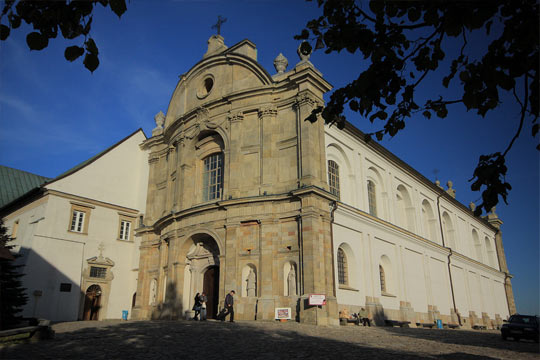
ŚWIĘTY KRZYŻ MOUNTAIN
Łysiec Mountain, commonly referred to as “Święty Krzyż” (Holy Cross) mountain was especially liked by witches ages ago. The folk legend has it that during their Sabbaths witches practiced witchcraft and organized hellish parties and dances. However, it is the remains of a stone heathen ring surrounding the top of the mountain and dating back to around 9th century.
Nowadays “Święty Krzyż” is famous in Poland and abroad for the Benedictine monastery and its Relics of the Holy Cross Tree. The monastery, now hosted by the Missionary Oblates, can boast of its 1000 years’ history. Visitors and pilgrims can see a Classicist church dating back to the 18th century and the chapel of the Oleśnicki Family containing Holy Cross Relics and a sepulchral crypt in its vaults. It is worth visiting the Mission Museum of the Missionary Oblates of the Virgin Mary as well as seeing the exhibition of the Świętokrzyski National Park. Tired visitors may try the monastery cuisine and drop in an old pharmacy, now a café, not only to have a cup of coffee or tea, but also buy traditional herbal medicines.
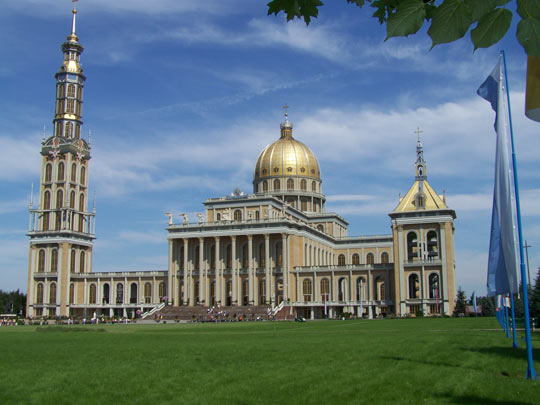
WIELKOPOLSKA – LAND OF MANY SAINTS
Virgin Mary’s Sanctuary in Lichen
Lichen constantly attracts crowds of pilgrims. They rush to see the painting of the Virgin Mary, the Sorrowful Queen of Poland as well as the biggest Polish temple, probably one of the biggest sacred buildings in Europe. It has been built since 1994, and its sumptuousness is literally breathtaking. The temple, designed by Barbara Bielecka, is a five-nave transept cruciform basilica (Latin cross) with a semicircular chancel. Its façade is headed by an impressive column portico. The whole building is covered with an enormous golden dome, visible from the distance of almost twenty kilometers. It has been estimated that the church can house 7000 people
The Stone Golgotha in Lichen
The miraculous painting is placed in St Dorota’s Church (neo-Gothic architecture). The tradition has it that it was found by Tomasz Kłossowski (a soldier and ex-landowner who had lost his fortune and taken on smithery) on his way back home from the Napoleonic wars. He hung the painting on a tree and, later, it turned out that it had miraculous power. Apart from the new basilica and St Dorota’s Church, tourists can also visit the Czestochowska Virgin Mary’s Church as well as take a walk in the surrounding park and admire numerous sacred and patriotic objects, such as a stone Golgotha or the monument of pope John Paul II.
The Church in Skulsk
The cult of the Virgin Mary the Sorrowful has been present in Skulsk for a few centuries. These days though, it is experiencing its revival. The pilgrimage season starts here in early spring and lasts till late autumn. The place is most frequently visited during the September indulgence (8-15 September). The legend has it that the Bolesław Chrobry’s knights saw the Virgin Mary on an island called Kepa Skulska. The king order to erect a chapel in these boggy fields. Soon, the chapel became the destination of pilgrimages. Presently, the pilgrims visit a church that replaced the chapel in 1810. Its Gothic Pieta – a wooden sculpture, dated at approximately 1420, nested in the late Baroque altar, captures visitors’ attention.
St Josef ’s Sanctuary in Kalisz
The place has an exceptional status among Poland’s pilgrimage sites. The cult of St Josef has been present here for 400 years, and the visiting pilgrims pray in front of the miraculous painting of the Holy Family, so far the only crowned picture of St Josef. The Sanctuary is located in the Kalisz collegiate of the Virgin Mary. Its beginning date back to the 13th century, yet in the middle of the 14th century the building underwent architectural modifications which gave it a Gothic shape. The building was partially destroyed in the late 18th century, later to be restored in the late Baroque style. The plenary indulgence takes place here on 19 March, but some pilgrims also visit this place on the 29 April (the priests – ex-prisoners of Dachau concentration camp) and 1 May (International Pilgrimage of Working People).
The Baroque Church on Swieta Góra near Gostyn
The Baroque church near Głogówek, known as Swieta Góra, is modeled on the Venetian Santa Maria della Salute. Its construction was initiated in 1675 by a Philippine, priest Stanisław Grudowicz, the founder of St Phillip’s Oratorio, located nearby. The work was supervised by Jerzy Catenazzi and his son Jan and, later, by Pompeo Ferrari. The latter is known for the dome, chancel and monastery buildings. The complex was fi nished in 1728. Swieta Góra is nowadays a popular and frequently visited sanctuary. The picture of the Virgin Mary with the Infant Jesus and a rose in her hands, painted approximately in 1540, (placed in the main altar) attracts masses of people on daily basis.
The Baroque Temple in Górka Klasztorna
The place has a long history, written down by the Bernardines as late as in the 17th century. According to their chronicles, in 1079 the place witnessed the appearance of the Virgin Mary. Nowadays, the Virgin Mary’s Sanctuary in Górka Klasztorna commemorates the appearance. Adjoining to the Baroque temple of the Virgin Mary the Immaculately Conceived are two wings of the Monastery of the Missionaries of the Holy Family. The missionaries have been looking after the sanctuary since 1923. The church has Baroque-Rococo interior decorations. In the churchyard there is a well from which pilgrims draw water which, ostensibly, gives good health.
The Way of the Cross in Ujście
The foundations were laid in 1893. Yet, 17 years had passed until the 14 chapels of the Way of the Cross (and some adjacent objects) stood on the steep slopes of the post-glacial stream valley of the Notec. Soon, Kalwaria became widely known in Wielkopolska. The faithful used to treat it as the destination of pilgrimages. During the World War II, the German military forces destroyed it. At the beginning of June 1976, overnight, 14 Stations of the Way of the Cross (decorated with sculptures) made by Jerzy Sobocinski replaced the destroyed chapels, in spite of the lack of permission from the authorities. The decision granting the restoration of the former Kalwaria was passed in 1997. The place hosts the greatest number of pilgrims on the first Sunday of July, the time of plenary indulgence.
The Collegiate in Szamotuły
A magnificent painting of the Kazanska Virgin Mary, the replica of the Russian icon presenting Virgin Mary the Consolation for the Tormented, has been the object of worship in Szamotuły Gothic collegiate for almost four centuries now. It was brought to Szamotuły by Aleksander Wolff, the then holder of the local castle. He placed it in the castle’s chapel. The icon would probably have stayed there for good if the Virgin Mary hadn’t shed bloody tears – the heartbreaking event happened on 24 April, 1665 and it was witnessed by eight people, including Wolff . A special committee appointed by the Poznan Curia classified it as a miracle and decided to move the icon to the collegiate.
Thus, the Virgin Mary of Consolation is the target of pilgrimages all year round, most of them in the period between March and September. The last Sunday of August ends the week of Virgin Mary’s glorification, celebrated here in exceptional dedication.
PELPLIN – CISTERCIAN CATHEDRAL AND GUTENBERG BIBLE
It has Gothic, Renaissance and Baroque interior decorations. Its late-Renaissance high altar is Poland’s largest and is believed to be the largest timber altar in Central Europe. The monastic buildings contain Gothic frescoes (15th c). The Diocesan Museum houses a rich collection of sacral art, including a Gutenberg bible printed in 1453 and two Gothic figures of Our Lady.
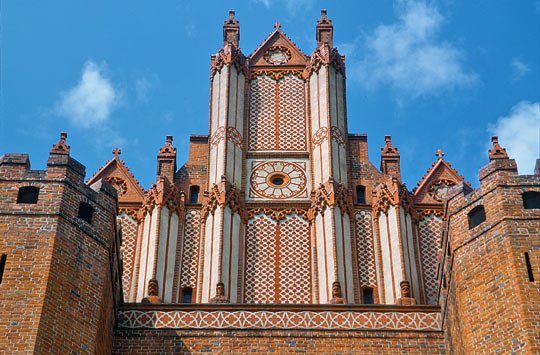
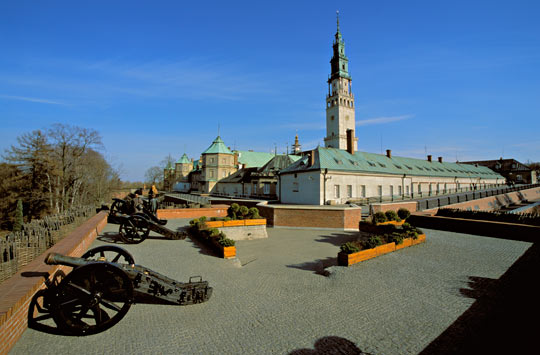
CZESTOCHOWA – SPIRITUAL CAPITAL OF POLAND
They flock to the Marian shrine in the Pauline monastery on Jasna Góra (Bright Mountain). The Chapel of the Miraculous Picture contains the icon of the Virgin Mary with the Christ child known as the Black Madonna which attracts millions of pilgrims every year. The monastic museum contains many pieces of art work and votive offerings. From Częstochowa, tourists can continue through the Kraków-Częstochowa Upland which is popular for hiking, climbing, biking and horseback riding.
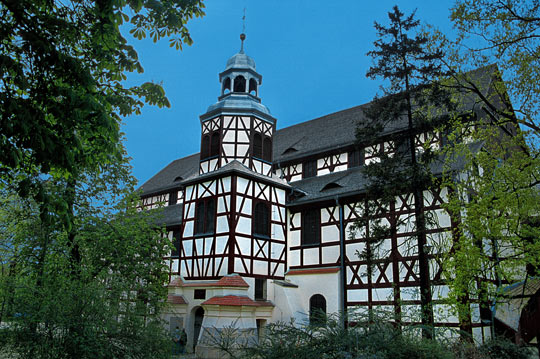
CHURCHES OF PEACE IN JAWOR AND ŚWIDNICA – TEMPLES WITH A MESSAGE
Both Protestant half-timber churches were erected in the mid-17th century, following the end of the Thirty Years’ War that ravaged large parts of Europe. Signing the Peace Treaty of Westphalia (1648), the emperor of Austria let the Protestants of Lower Silesia erect three ‘churches of peace’. They were to commemorate the end of the devastating war and religious conflicts.
Both temples were not supposed to be reminiscent of traditional churches. They were to be constructed with the use of low quality materials and located within the range of a cannonball from the city walls. And this is how two Europe’s biggest wood-and-clay shingled constructions were built, each seating a few thousand people. With modestly looking outside walls, they both have rich baroque decorations inside.
The Church of Peace in Świdnica is located on the old Protestant cemetery, away from the oldest part of the city. The paintings that cover the walls and ceiling depict visions of St John Evangelist described in his Apocalypse. They also represent coats-of-arms of the most prominent members of the church community as well as views of the local towns and residences.
The Church of Peace in Jawor (30 km from Świdnica) is also richly decorated with 180 paintings representing scenes from the Old and New Testaments as well as coats-of-arms belonging to different families and guilds.
Both towns boast rich historical heritage. In the Middle Ages, Świdnica was the capital of an independent principality. Tourists willingly visit historical monuments grouped within the oldest quarters of both towns.



